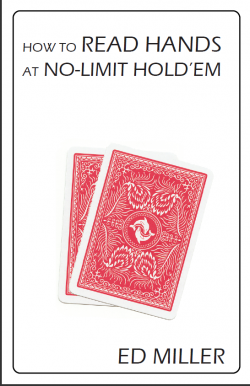 I had the great pleasure of reviewing a pre-release version of Ed Miller’s new book, How to Read Hands at No Limit Hold’Em. I call it a great pleasure because I’ve been a big fan of Ed’s writings over the years. I religiously read his 2+2 postings and was one of the first in line to purchase his first book, Small Stakes Hold’Em, that he co-wrote David Sklanksy and Mason Malmuth. That was the first poker book that I really connected with.
I had the great pleasure of reviewing a pre-release version of Ed Miller’s new book, How to Read Hands at No Limit Hold’Em. I call it a great pleasure because I’ve been a big fan of Ed’s writings over the years. I religiously read his 2+2 postings and was one of the first in line to purchase his first book, Small Stakes Hold’Em, that he co-wrote David Sklanksy and Mason Malmuth. That was the first poker book that I really connected with.
Miller’s How to Read Hands is one of the missing pieces in poker literature. There really isn’t a good book on reading hands. About the closest you can come is Caro’s writings on tells and-or books that gloss over hand reading (or fail to discuss the topic at all) but are mainly focused on playing your own hand.
Miller’s book takes a different approach. You actually learn how to read hands. Ed walks you through assessing your opponents, pre-flop action, flop action, turn action, and river actions to help you narrow down what your opponent can be holding. You start with a range of hands that different players might play in various situations and narrowing down that range as more cards are exposed and betting actions give you more and more valuable information.
As with many of Ed’s writings, the focus in How to Read Hands is on besting low-limit opponents. Phil Ivey is still going to be a tough read but you’ll have a good handle on how to deconstruct and analyse a hand against your typical $100 NL opponents by the time you’re done with the book.
My only real criticism of the book is that the guys Ed sees at his low limit games and the ones I often encounter aren’t really the same. His examples of nit, regulars, and fish hand ranges may not be a great fit for the types of players you encounter in your local game.
But it’s a minor criticism since the book does push you towards developing your own ranges for player types based on your own experiences. What Ed sees in a Las Vegas card room might not match the types of players you encounter at a LA card room. You need to adjust your ranges based on your observations.
Overall it’s a solid book on a topic that isn’t covered in any great detail elsewhere. In fact, I share Miller’s frustration when he talks about people putting their opponents on a hand but being unable to explain why.
I think our natural tendency as players is to either put our opponent on the scariest hand they could have or to wishfully think that they’re holding a weak hand. We tend to look for the obvious and on a board of:
7s 8d 9h
We immediately jump to the conclusion that either your opponent is holding TJ, 56, 6T. or some random hand that we have beat. We tend to polarize the range. Either it’s a monster or complete air.
But we need to ask whether or not the action fits. How likely is it that your opponent raised from UTG with 6T? If you know that this guy’s pre-flop raising range is AA-TT or AK – AJ then certain hands like 56 make no sense.
It sounds basic but it’s amazing how many people cannot articulate how they arrive at a hand that they’ve put their opponent on. How many times have you heard someone claim that “they just knew it”?
Ed walks you through that process. Instead of “just knowing” you can use a methodical approach to developing a hand range for your opponents and then slowly eliminating hands as your progress on each street.
Having a pretty good idea where your opponent is in a hand is a huge advantage. I know that sounds rather obvious but how many times do you call that river bet with middle pair when your opponent’s actions have been screaming overpair? How many times do you check it down on the river because you’re not confident enough in your read to put in a value bet? How much has that cost you?
Other than playing too many hands, not being able to accurately put your opponent on a range of hands is, IMHO, the biggest difference between mediocre players and good players.
I really can’t recommend How to Read Hands enough. It’s a true original in a sea of poker books that do nothing but rehash the same old strategy concepts. I can truly say that this is one of the first books I’ve read in years that I’ve felt is a must-have book for aspiring poker players. Don’t buy this book at your own peril.

Ian, you can also purchase it from Ed’s site.
Hi,
Nice report.
Would you know where I could purchase the book from apart form Amazon.
Thanks
Ian
Thanks Charlie. I had been planning on responding to Alexander.
Here is an excerpt from Ed’s Blog.
http://www.notedpokerauthority.com/articles/hand-reading-on-the-turn-an-excerpt-from-the-new-book.html
Are there free chapters for reading on this book? It would be nice if there was one or two. I like to be able to scan through a few pages before buying a book. I’m old school. That is what I do when I’m at a a B&M bookstore.
Thanks for confirming that.
Yup it is Currently as an e-book, I checked his Facebook which he has a link to buy it there
At the moment, I believe that Ed is selling via his website as an eBook.
Bill:
I was reading Doyle Brunson’s autobiography recently where he related the story of his first encounter at the poker table with the legendary Johnny Moss. (At the time, circa mid-to-late 1950’s, Doyle was in his early twenties – a fairly young man.) Doyle related one hand in particular where Moss bet a pot very aggressively and Doyle called him down with a Jack-high hand. Doyle correctly “read” that Moss had missed a straight draw. Doyle says it was that read (and that hand) that boosted his confidence that he had truly emerged as a professional. Up to that point, among the relatively small circle of thirty or so Texas road gamblers, Johnny Moss was generally acknowledged as the best of the lot. I’ve always been amazed when I see “pros” (like Doyle) make those kind of gutsy “high card wins” reads – especially on all-in pots for all their chips. I suppose I’m too much of an ABC poker player, but I always had the sense that making such calls was clairvoyance or ESP – a “skill” bordering on magic. In this book, Ed is making the point that this is really a process of sorting out all the clues and putting all the pieces together. (In other words, it’s a logical process.) This kind of hand reading ability is definitely what separates the better players from all the rest of us.
I’ll definitely be buying a copy of this book. BTW, when will Ed’s new book be available? I searched for it yesterday on Amazon.com and couldn’t find it.